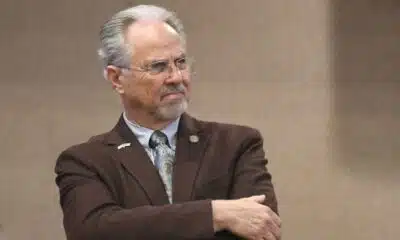News from the South - Louisiana News Feed
Democratic AGs allege Trump administration is freezing federal funds despite court order • Louisiana Illuminator
Democratic AGs allege Trump administration is freezing federal funds despite court order
by Jennifer Shutt, Louisiana Illuminator
February 7, 2025
WASHINGTON — Democratic attorneys general from throughout the country on Friday asked a federal judge to enforce a temporary restraining order he issued late last month, alleging the Trump administration is not complying with the court’s ruling.
The top Democrat on the U.S. Senate Appropriations Committee also raised questions about the ongoing pause in some grants and loans.
The attorneys general wrote in an emergency motion that “there has been an ever-changing kaleidoscope of federal financial assistance that has been suspended, deleted, in transit, under review, and more since entry of the Order.”
They asked Chief Judge John J. McConnell Jr. of the U.S. District Court in Rhode Island, who issued the temporary restraining order on Jan. 31, to order the Trump administration “to immediately restore funds and desist from the federal funding pause until the preliminary injunction motion can be heard and decided, a process which is proceeding expeditiously in separate proceedings before this Court.”
McConnell is giving the Department of Justice until Sunday to respond.
Head Start programs stalled, meetings canceled
The attorneys general wrote in their 21-page emergency motion filed with McConnell on Friday that “(d)espite the Court’s order, Defendants have failed to resume disbursing federal funds in multiple respects.”
They wrote the Trump administration hasn’t begun distributing funding Congress approved in the Inflation Reduction Act or the Infrastructure Investment and Jobs Act, also known as the bipartisan infrastructure law.
They alleged the National Institutes of Health “abruptly cancelled an advisory committee review meeting with Brown University’s School of Public Health for a $71 million grant on dementia care research, saying ‘all federal advisory committee meetings had been cancelled.’”
Head Start programs in Michigan and Vermont were unable to access funds on Feb. 5, they wrote.
The brief also says the Centers for Disease Control and Prevention and the Health Resources and Services Administration “renewed stop work orders to a University of Washington program doing global HIV prevention work” on Feb. 5 and Feb. 6.
The attorneys general wrote they tried to work through the delay in funding with the Trump administration but were unsuccessful, in part, due to differing interpretations of Judge McConnell’s temporary restraining order.
Fight over freeze
The Office of Management and Budget released a two-page memo in late January announcing that a funding freeze on trillions of dollars in grant and loan programs was set to begin Tuesday, Jan. 28 at 5 p.m.
The memo led to confusion throughout the country as organizations that receive federal funding tried to determine if they would be affected. Members of Congress were also unsure about which programs would be paused and which wouldn’t, despite being in the branch of government that controls spending.
Just before the freeze was set to take effect, Judge Loren L. AliKhan of the U.S. District Court of the District of Columbia issued a short-term administrative stay preventing the Trump administration from beginning the funding freeze.
That separate lawsuit was filed by the National Council of Nonprofits, American Public Health Association, Main Street Alliance and Sage.
OMB then withdrew the memo, but White House press secretary Karoline Leavitt posted on social media that rescinding the memo was “NOT a rescission of the federal funding freeze.”
“It is simply a rescission of the OMB memo,” Leavitt wrote. “Why? To end any confusion created by the court’s injunction.”
“The President’s EO’s on federal funding remain in full force and effect, and will be rigorously implemented,” she added.
The Department of Justice moved to dismiss both cases after the OMB memo was rescinded, but both judges declined.
McConnell later issued a temporary restraining order in the lawsuit filed by the Democratic attorneys general from 22 states and the District of Columbia. That was followed by a separate temporary restraining order from AliKhan.
‘Businesses left wondering’
U.S. Sen. Patty Murray of Washington state, ranking member of the Senate Appropriations Committee, said Friday entire local economies are at risk.
“The uncertainty alone over the fate of these investments is putting jobs on the chopping block, hurting American businesses left wondering whether contracts they’ve inked mean anything, and jeopardizing entire local economies,” Murray wrote in a statement. “What Trump is doing could shutter critical infrastructure projects in virtually every community, kill good-paying jobs, choke off funding for farmers, stop innovation in its tracks, leave massive holes in local communities’ budgets, and so much more.
“Once again: if Donald Trump or Elon Musk want to gut funding that’s creating good-paying jobs all across America, they can take their case to Congress and win the votes they need to do it. Defying the constitution to unilaterally rip away your tax dollars is not how this works.”
Murray released a five-page document detailing some of the areas where the Trump administration’s funding freeze continues to affect grant and loan programs.
Last updated 5:20 p.m., Feb. 7, 2025
Louisiana Illuminator is part of States Newsroom, a nonprofit news network supported by grants and a coalition of donors as a 501c(3) public charity. Louisiana Illuminator maintains editorial independence. Contact Editor Greg LaRose for questions: info@lailluminator.com.
News from the South - Louisiana News Feed
Saturday 10 PM Tropics Update: One far-off tropical wave to watch
SUMMARY: A tropical wave near Africa is emerging over the Atlantic but remains disorganized. The National Hurricane Center gives it a 60% chance to develop into a depression or tropical storm, possibly becoming Gabrielle. This system may move northward, staying over the open Atlantic and away from the Gulf, posing no immediate threat. Since the last named storm in late August, stable air, dry conditions, and increased wind shear have suppressed tropical activity in the Atlantic. The next storm names are Gabrielle, Humberto, and Imelda, with only the current wave showing potential for development at this time.
Meteorologist Alexandra Cranford tracks a lone disturbance with a chance of development on Saturday night, September 13, 2025.
News from the South - Louisiana News Feed
Haynes wanted in on Wildlife bribery scheme too, informant says
SUMMARY: Dusty Guidry, a former consultant who pleaded guilty to accepting $800,000 in bribes, testified that Assistant District Attorney Gary Haynes sought involvement in a bribery scheme at the Louisiana Department of Wildlife & Fisheries. Haynes, on trial for conspiracy, bribery, money laundering, and obstruction, was previously appointed to run Lafayette’s pretrial diversion program after supporting DA Don Landry. Guidry revealed Haynes pressured him to include him in a similar diversion program scheme at Wildlife & Fisheries, receiving checks totaling $90,000. The scheme involved splitting bribes among Guidry, vendor Leonard Franques, and former department secretary Jack Montoucet, who has also been charged. The statewide program never launched.
Read the full article
The post Haynes wanted in on Wildlife bribery scheme too, informant says appeared first on thecurrentla.com
News from the South - Louisiana News Feed
OPPJ Comprehensive Plan
SUMMARY: The Ouachita Parish Police Jury is conducting a series of community meetings to gather public input for their comprehensive plan guiding future growth. Police Jury members, including Larry Bratton from District D, emphasize the importance of reflecting residents’ voices in the master plan. Community members participated in interactive stations, allocating resources to priorities like infrastructure and downtown development, to help shape goals for the next 2, 5, and 20 years. Landscape architect Matt Pizatella and partners from Atlas support the effort. Bratton stresses that without proactive planning, the parish risks costly and less beneficial outcomes in the long term.
OPPJ Comprehensive Plan
-
News from the South - West Virginia News Feed7 days ago
Protesters in D.C. flood the streets demanding an end to Trump’s military deployment
-
News from the South - Missouri News Feed7 days ago
1587 Prime gives first look at food, cocktail menu ahead of grand opening in KC
-
Mississippi News Video7 days ago
Interview: Come see Baptist at WTVA Senior Health Fair
-
News from the South - Arkansas News Feed6 days ago
‘One Pill Can Kill’ program aims to reduce opioid drug overdose
-
News from the South - Alabama News Feed6 days ago
Alabama lawmaker revives bill to allow chaplains in public schools
-
The Conversation7 days ago
How is paint made?
-
News from the South - Arkansas News Feed6 days ago
Arkansas’s morning headlines | Sept. 9, 2025
-
News from the South - Texas News Feed6 days ago
‘Resilience and hope’ in Galveston: 125 years after greatest storm in US history | Texas











































